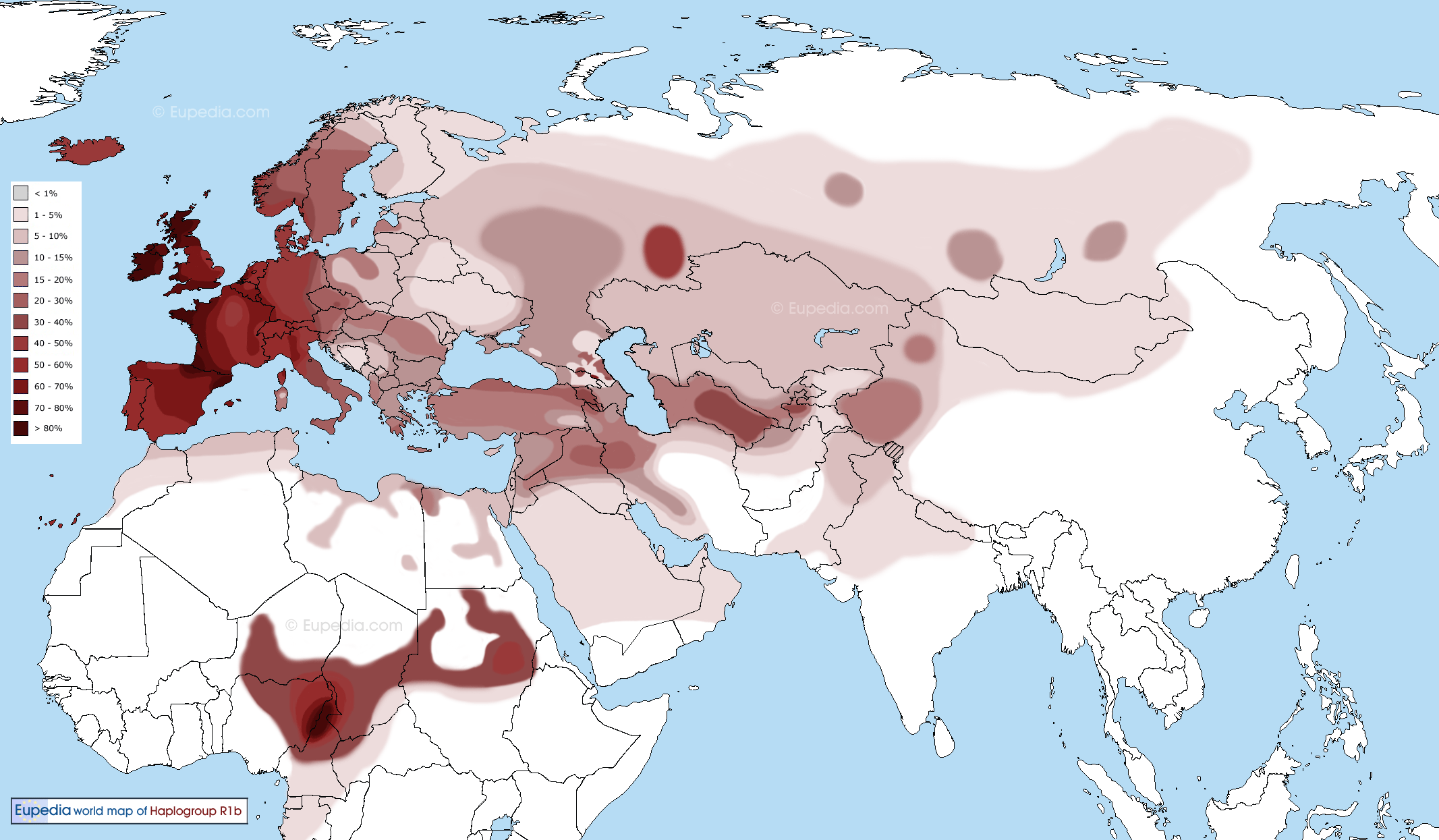The new Haak et al. 2015 paper confirmed that Yamna Proto-Indo-Europeans belonged to haplogroup R1b. Four out of six R1b samples from the Volga-Ural region belonged to the R1b-Z2103 subclade, a branch of what used to be called R1b-ht35, the eastern variant of R1b-M269. Obviously the samples tested were on the far north-eastern reaches of the Yamna horizon, and I expect that samples from more southern and western areas of Yamna would yield other R1b subclades, notably the L51 branch from which Western Europeans descend.
We can reasonably assume that all R1b-M269 samples that once fit into the ht35 or L23* category are Z2103, simply because there are only two known subclade under L23 : L51 (ht15) and Z2103 (ht35).

What is not clear from my European map above is that Z2103 has a very wide distribution covering also Central Asia, South Asia and West Asia.
Most of the R1b in Asia on the map below is either M73 or Z2103, although the latter is dominant everywhere.

According to the R1b1a2 (P312- U106-) DNA Project, Z2103 has five main subclades.
- L584 (including L943) : found mostly in the South Caucasus, Turkey, Iraq and Iran, but also in Poland, Germany and Austria.
- L277.1 : found in Russia, Central Asia, Bulgaria, India and the Middle East (Iraq, Lebanon).
- CTS7822 (including CTS9219) : found in Russia (including Chuvashia), Ukraine, Poland, Hungary, the Balkans, Armenia, Italy, Spain, Britain and Ireland.
- CTS7763 : found in Turkey, Bulgaria and Italy.
- Z2109 : found in Germany and Scotland.
Overall the distribution of the bulk of Z2103 samples is reminiscent of that of R1a-Z93.
For example R1b-L277.1 seems to have expanded from Russia to Central Asia then to India and the Middle East, just like the R1a-L657 subclade of Z93.
R1b-L584 looks more Mitanni, Iranian, Scythian and maybe also Armenian. It's West Asian distribution matches that of the R1a-Z2124 subclade of Z93.
R1b-CTS7822 is mostly central and eastern European and correlates more with R1a-Z280.
R1b-CTS7763 appears to be confined to the greater ancient Greece (not data from Greece itself, but most of the Greek R1b-L23 could belong to this subclade considering its presence in South Italy and West Anatolia). It doesn't seem to correlate with any R1a subclade.
I wouldn't be surprised if the eastern Yamna Z2103 samples tested later formed the Poltavka culture, which eventually merged with the Abashevo culture to form the Sintashta culture (presumably the main source of Asian R1a-Z93). Through a founder effect or through political domination, R1a-Z93 lineages would have become far more numerous than R1b-Z2103 after the expansion to Central and South Asia.
What is certain is that one of the Z2103 samples came from the Orenburg oblast just south of the Urals, in what was soon to become the Poltavka culture. I already envisioned this scenario in my migrations maps 5 years ago, and the current data is in perfect agreement with it. Back then Z2103 had not yet been discovered, so I couldn't have made predictions about it. Even today data is very scarce about L23 subclades, especially among Volga-Ural ethnic groups, in Central Asia and in the Balkans.

We can reasonably assume that all R1b-M269 samples that once fit into the ht35 or L23* category are Z2103, simply because there are only two known subclade under L23 : L51 (ht15) and Z2103 (ht35).

What is not clear from my European map above is that Z2103 has a very wide distribution covering also Central Asia, South Asia and West Asia.
Most of the R1b in Asia on the map below is either M73 or Z2103, although the latter is dominant everywhere.

According to the R1b1a2 (P312- U106-) DNA Project, Z2103 has five main subclades.
- L584 (including L943) : found mostly in the South Caucasus, Turkey, Iraq and Iran, but also in Poland, Germany and Austria.
- L277.1 : found in Russia, Central Asia, Bulgaria, India and the Middle East (Iraq, Lebanon).
- CTS7822 (including CTS9219) : found in Russia (including Chuvashia), Ukraine, Poland, Hungary, the Balkans, Armenia, Italy, Spain, Britain and Ireland.
- CTS7763 : found in Turkey, Bulgaria and Italy.
- Z2109 : found in Germany and Scotland.
Overall the distribution of the bulk of Z2103 samples is reminiscent of that of R1a-Z93.
For example R1b-L277.1 seems to have expanded from Russia to Central Asia then to India and the Middle East, just like the R1a-L657 subclade of Z93.
R1b-L584 looks more Mitanni, Iranian, Scythian and maybe also Armenian. It's West Asian distribution matches that of the R1a-Z2124 subclade of Z93.
R1b-CTS7822 is mostly central and eastern European and correlates more with R1a-Z280.
R1b-CTS7763 appears to be confined to the greater ancient Greece (not data from Greece itself, but most of the Greek R1b-L23 could belong to this subclade considering its presence in South Italy and West Anatolia). It doesn't seem to correlate with any R1a subclade.
I wouldn't be surprised if the eastern Yamna Z2103 samples tested later formed the Poltavka culture, which eventually merged with the Abashevo culture to form the Sintashta culture (presumably the main source of Asian R1a-Z93). Through a founder effect or through political domination, R1a-Z93 lineages would have become far more numerous than R1b-Z2103 after the expansion to Central and South Asia.
What is certain is that one of the Z2103 samples came from the Orenburg oblast just south of the Urals, in what was soon to become the Poltavka culture. I already envisioned this scenario in my migrations maps 5 years ago, and the current data is in perfect agreement with it. Back then Z2103 had not yet been discovered, so I couldn't have made predictions about it. Even today data is very scarce about L23 subclades, especially among Volga-Ural ethnic groups, in Central Asia and in the Balkans.

Last edited:


